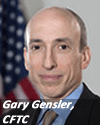The leading US derivatives regulator will push for new direct market access (DMA) rules to meet what it sees as a growing need to control market access in the high-frequency age.
Last week, Commodity Futures Trading Commission (CFTC) chairman Gary Gensler said in a speech to the US Senate Committee on Banking, Housing and Urban Affairs, the Commission was working with other regulators to outline a new approach on DMA.
“Commission staff currently is developing a concept release for public comment concerning the testing of systems and supervision of market participants with direct electronic market access,” Gensler said.
“These concepts will be designed to address potential risks that high-frequency traders and others who have direct market access may cause,” he said.
A year after sell-side firm Knight Capital came close to extinction when a rogue algo led to a US$440 million loss, the industry has shown some resilience in this area, but Gensler’s comments suggest industry-led action is not sufficient.
This particular area is subject to convergence of certain elements that have attracted controversy, namely algorithmic trading, high-frequency trading (HFT) and DMA, which is most commonly used by HFT firms to access a broad range of markets.
Matt Samelson, principal at capital markets consultancy Woodbine Associates, said market participants had invested significant resources to avoid being the next high-profile algo glitch. However, any new rules governing DMA, and in particular based on the effects of HFT, should be cemented in an evidence-based approach.
“There certainly needs to be greater rules on market access, but until we understand the positive and negative aspects of high-frequency trading through empirical evidence, new regulation may not drive meaningful results,” Samelson told theTRADEnews.com.
Long road
Typically, a concept release is the first in a long process of regulatory development. It can include industry roundtables in addition to written submissions, which feed into a rule proposal, which then passes through a similar consultation period, before final rules are drawn and implemented.
But this lengthy process, which is often subject to delays, is there to serve the industry, attests Samelson.
“The CFTC has called for greater testing and controls around market access and surveillance and the market would benefit from new rules in this area to maintain orderly markets,” he said.
In July, the CFTC displayed its ability to clampdown on aggressive, unlawful market behaviour linked to DMA and algorithmic trading through use of the Dodd-Frank Act.
The Commission ordered Panther Energy Trading and its principal Michael J. Corscia to pay US$2.8 million for ‘spoofing’ orders in commodity futures contracts, by which bids and offers were placed, then cancelled before execution to manipulate price swings. Corscia had designed a computer program to specifically target these contracts and was able to make a profit of nearly US$1.5 million.
This was a joint action with UK regulator the Financial Conduct Authority, which similarly fined Corscia US$903,176 for spoofing contracts on the ICE Futures Europe exchange, which he accessed through a DMA connection.
Stretched resources
Despite the immense workload of Dodd-Frank implementation signalling it may soon relent, the CFTC still faces the combination of stretched resources and growing challenges that will make new initiatives hard work.
As Gensler said in his speech last week, “The agency currently is operating on a budget of $195 million after sequestration and has a staff of 685. That is only 8% more staff than we had 20 years ago.”
In that period, the US futures market has expanded five-fold, the swaps market is five times larger, and technology has lurched forward, Gensler added. Although claiming the Commission would work with other regulators on the concept release, the Securities and Exchange Commission (SEC), had already set out its rules on DMA, and so may be unwilling to take the lead on market access reform.
In November 2010, the SEC adopted its rules on market access, with full compliance due in November the following year.
